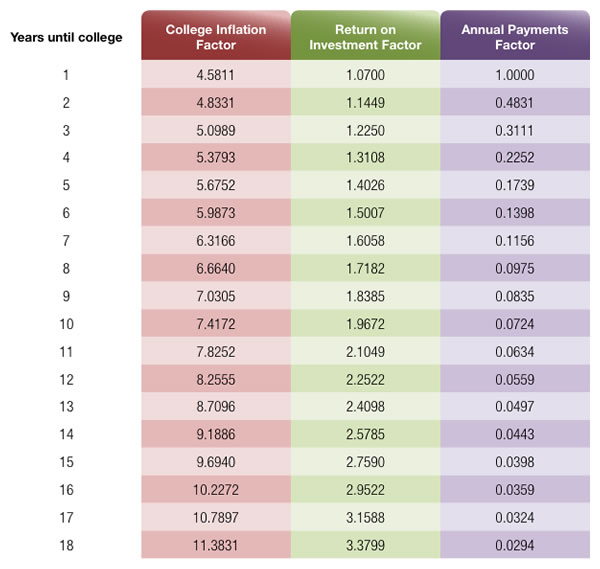Healthcare Provider Update: Offers health, dental, and vision insurance, along with prescription drug coverage and pre-tax savings programs. Benefits include employer-paid disability and life insurance, wellness programs, and a 401(k) match1. As ACA premiums rise and subsidies expire, Alliants comprehensive employer-sponsored plans may offer more predictable costs and better coverage than marketplace alternatives. Click here to learn more
It doesn’t take a degree in finance to see the cost of college continues to rise.
In its 2017 report, the College Board showed that public four-year institutions raised prices an average of 3.2% annually between the 2007-08 and 2017-18 school years. Put another way, a $5,000 education in 2007-08 would cost $6,851 in 2017-18.
For a few families, the lion’s share of education costs falls on parents and, in some cases, on grandparents. For our Alliant Energy clients who are parents you may already know, generally, the majority of families rely on a combination of scholarships, grants, financial aid, part-time jobs, and parent support to help pay the cost.
For Alliant Energy employees who have children approaching college age, a good first step is estimating the potential costs. The accompanying worksheet can help you get a better idea about the cost of a four-year college.
For Alliant Energy employees who already put money away for college, the worksheet will take that amount into consideration. For Alliant Energy employees who haven’t, it’s never too late to start.
Resources
There are a number of resources that can help individuals prepare for college. The U.S. government distributes certain information on colleges and costs. Here are two sites for these Alliant Energy employees to consider reviewing:
www.studentaid.ed.gov
The government’s college and financial aid portal.
Featured Video
Articles you may find interesting:
- Corporate Employees: 8 Factors When Choosing a Mutual Fund
- Use of Escrow Accounts: Divorce
- Medicare Open Enrollment for Corporate Employees: Cost Changes in 2024!
- Stages of Retirement for Corporate Employees
- 7 Things to Consider Before Leaving Your Company
- How Are Workers Impacted by Inflation & Rising Interest Rates?
- Lump-Sum vs Annuity and Rising Interest Rates
- Internal Revenue Code Section 409A (Governing Nonqualified Deferred Compensation Plans)
- Corporate Employees: Do NOT Believe These 6 Retirement Myths!
- 401K, Social Security, Pension – How to Maximize Your Options
- Have You Looked at Your 401(k) Plan Recently?
- 11 Questions You Should Ask Yourself When Planning for Retirement
- Worst Month of Layoffs In Over a Year!
- Corporate Employees: 8 Factors When Choosing a Mutual Fund
- Use of Escrow Accounts: Divorce
- Medicare Open Enrollment for Corporate Employees: Cost Changes in 2024!
- Stages of Retirement for Corporate Employees
- 7 Things to Consider Before Leaving Your Company
- How Are Workers Impacted by Inflation & Rising Interest Rates?
- Lump-Sum vs Annuity and Rising Interest Rates
- Internal Revenue Code Section 409A (Governing Nonqualified Deferred Compensation Plans)
- Corporate Employees: Do NOT Believe These 6 Retirement Myths!
- 401K, Social Security, Pension – How to Maximize Your Options
- Have You Looked at Your 401(k) Plan Recently?
- 11 Questions You Should Ask Yourself When Planning for Retirement
- Worst Month of Layoffs In Over a Year!
www.collegeboard.org
The group that administers the SAT test.
Estimating the Cost of College


What is the purpose of Alliant Energy's 401(k) Savings Plan?
The purpose of Alliant Energy's 401(k) Savings Plan is to help employees save for retirement by allowing them to contribute a portion of their salary to a tax-advantaged account.
How can I enroll in Alliant Energy's 401(k) Savings Plan?
Employees can enroll in Alliant Energy's 401(k) Savings Plan by completing the online enrollment process through the employee portal or by contacting the HR department for assistance.
What types of contributions can I make to Alliant Energy's 401(k) Savings Plan?
Employees can make pre-tax contributions, Roth (after-tax) contributions, and may also have the option for catch-up contributions if they are age 50 or older in Alliant Energy's 401(k) Savings Plan.
Does Alliant Energy offer a company match on 401(k) contributions?
Yes, Alliant Energy offers a company match on employee contributions to the 401(k) Savings Plan, which helps to enhance the overall retirement savings.
What is the maximum contribution limit for Alliant Energy's 401(k) Savings Plan?
The maximum contribution limit for Alliant Energy's 401(k) Savings Plan is set by the IRS and can change annually. Employees should check the current limits for the specific year.
When can I start withdrawing from my Alliant Energy 401(k) Savings Plan?
Employees can typically start withdrawing from their Alliant Energy 401(k) Savings Plan without penalty at age 59½, or earlier in cases of hardship or other qualifying events.
Are loans available from Alliant Energy's 401(k) Savings Plan?
Yes, Alliant Energy may allow employees to take loans from their 401(k) Savings Plan, subject to specific terms and conditions set by the plan.
How does Alliant Energy's 401(k) Savings Plan handle investment options?
Alliant Energy's 401(k) Savings Plan provides a variety of investment options, including mutual funds and other investment vehicles, allowing employees to choose based on their risk tolerance and retirement goals.
Can I change my contribution percentage to Alliant Energy's 401(k) Savings Plan?
Yes, employees can change their contribution percentage to Alliant Energy's 401(k) Savings Plan at any time through the employee portal or by contacting HR.
What happens to my Alliant Energy 401(k) Savings Plan if I leave the company?
If an employee leaves Alliant Energy, they have several options for their 401(k) Savings Plan, including rolling it over to a new employer's plan, an IRA, or cashing it out (though this may incur taxes and penalties).
/General/General%202.png?width=1280&height=853&name=General%202.png)



-2.png?width=300&height=200&name=office-builing-main-lobby%20(52)-2.png)









.webp?width=300&height=200&name=office-builing-main-lobby%20(27).webp)


-2.png)









.webp)